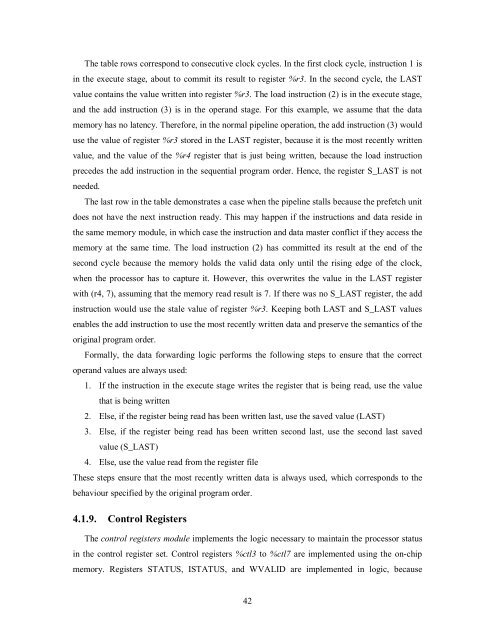Soft-Core Processor Design - CiteSeer
Soft-Core Processor Design - CiteSeer
Soft-Core Processor Design - CiteSeer
Create successful ePaper yourself
Turn your PDF publications into a flip-book with our unique Google optimized e-Paper software.
The table rows correspond to consecutive clock cycles. In the first clock cycle, instruction 1 is<br />
in the execute stage, about to commit its result to register %r3. In the second cycle, the LAST<br />
value contains the value written into register %r3. The load instruction (2) is in the execute stage,<br />
and the add instruction (3) is in the operand stage. For this example, we assume that the data<br />
memory has no latency. Therefore, in the normal pipeline operation, the add instruction (3) would<br />
use the value of register %r3 stored in the LAST register, because it is the most recently written<br />
value, and the value of the %r4 register that is just being written, because the load instruction<br />
precedes the add instruction in the sequential program order. Hence, the register S_LAST is not<br />
needed.<br />
The last row in the table demonstrates a case when the pipeline stalls because the prefetch unit<br />
does not have the next instruction ready. This may happen if the instructions and data reside in<br />
the same memory module, in which case the instruction and data master conflict if they access the<br />
memory at the same time. The load instruction (2) has committed its result at the end of the<br />
second cycle because the memory holds the valid data only until the rising edge of the clock,<br />
when the processor has to capture it. However, this overwrites the value in the LAST register<br />
with (r4, 7), assuming that the memory read result is 7. If there was no S_LAST register, the add<br />
instruction would use the stale value of register %r3. Keeping both LAST and S_LAST values<br />
enables the add instruction to use the most recently written data and preserve the semantics of the<br />
original program order.<br />
Formally, the data forwarding logic performs the following steps to ensure that the correct<br />
operand values are always used:<br />
1. If the instruction in the execute stage writes the register that is being read, use the value<br />
that is being written<br />
2. Else, if the register being read has been written last, use the saved value (LAST)<br />
3. Else, if the register being read has been written second last, use the second last saved<br />
value (S_LAST)<br />
4. Else, use the value read from the register file<br />
These steps ensure that the most recently written data is always used, which corresponds to the<br />
behaviour specified by the original program order.<br />
4.1.9. Control Registers<br />
The control registers module implements the logic necessary to maintain the processor status<br />
in the control register set. Control registers %ctl3 to %ctl7 are implemented using the on-chip<br />
memory. Registers STATUS, ISTATUS, and WVALID are implemented in logic, because<br />
42














